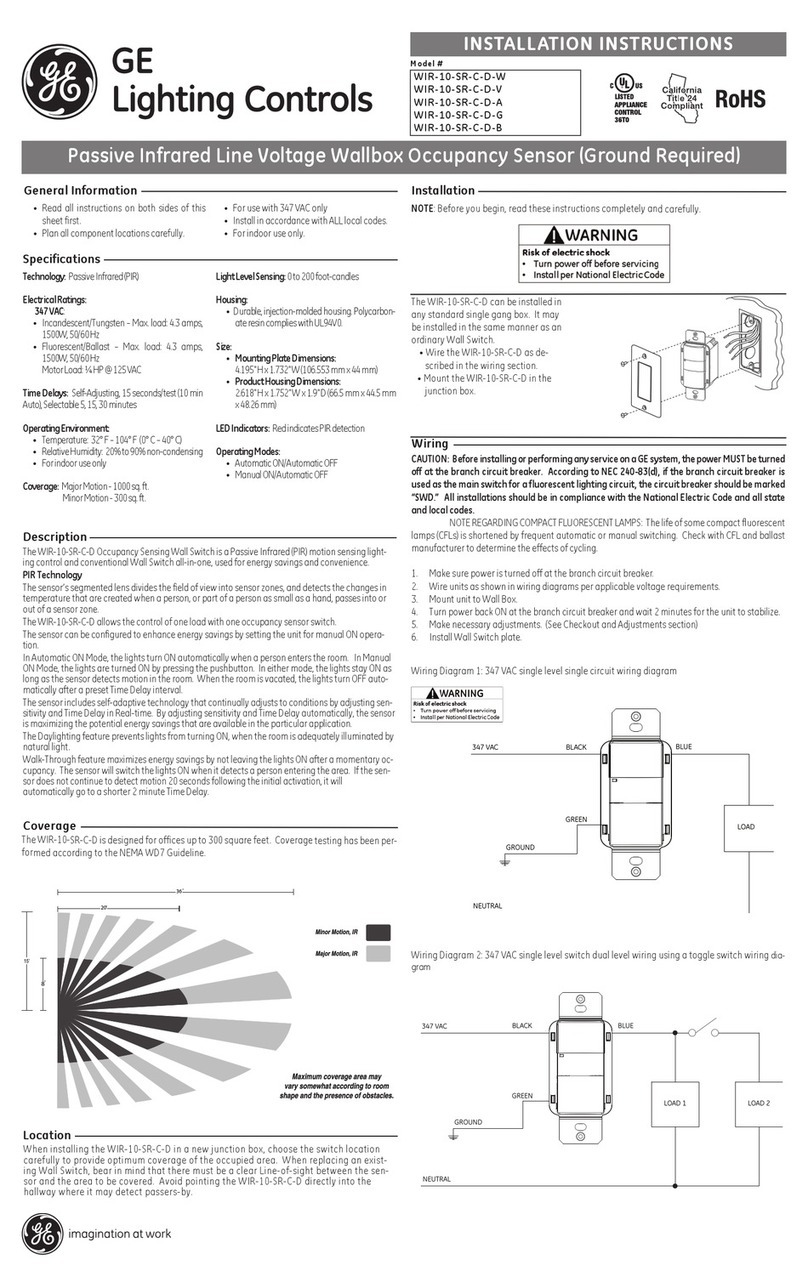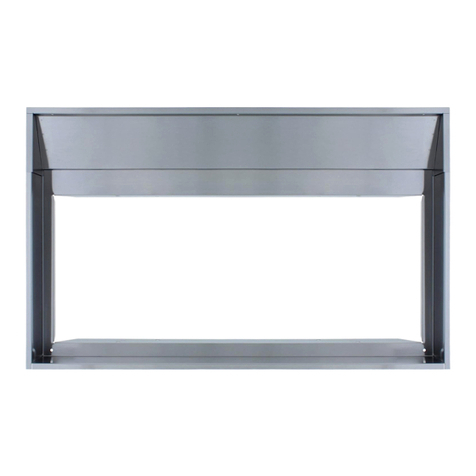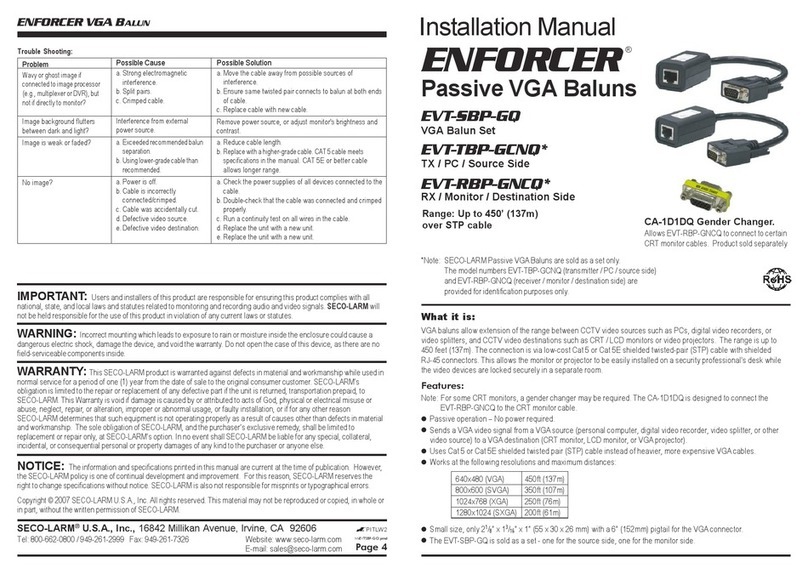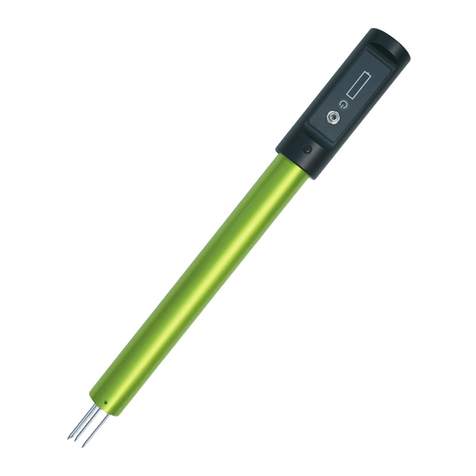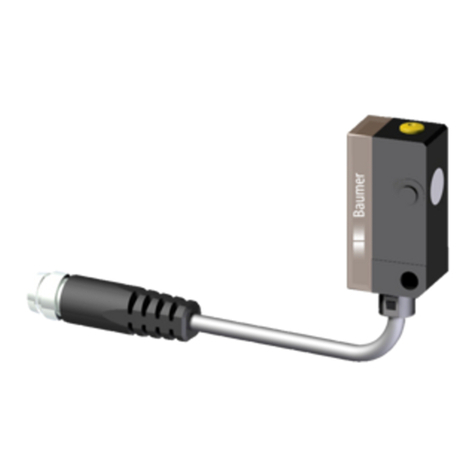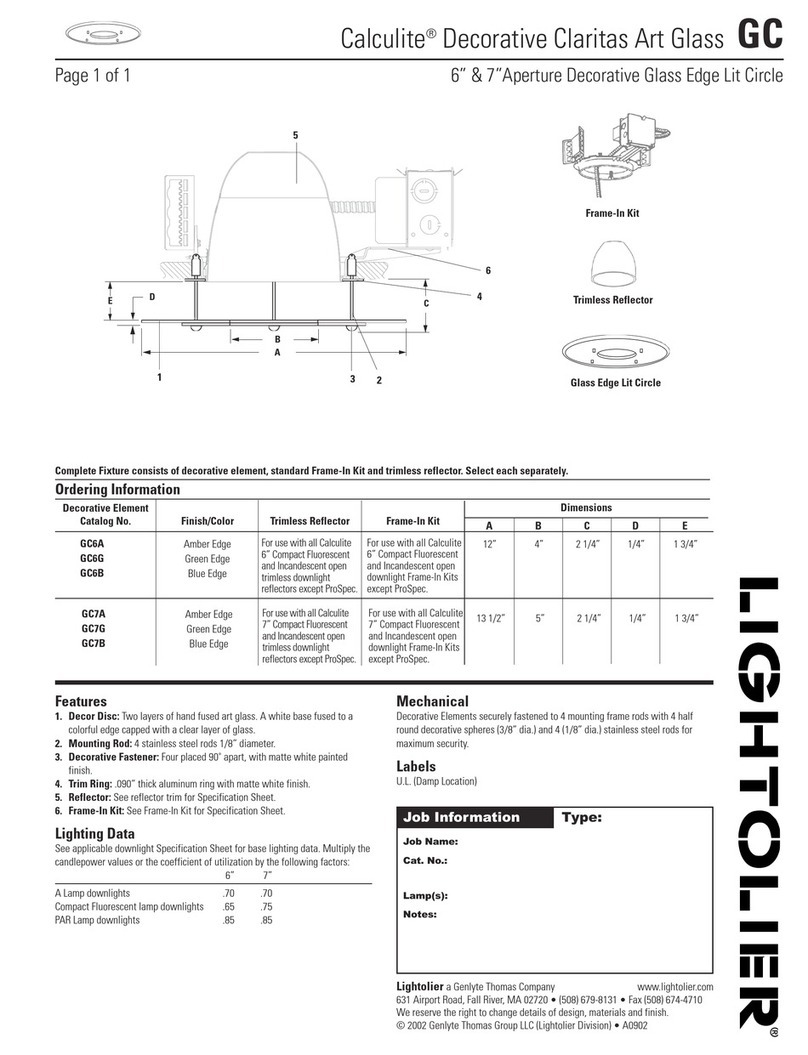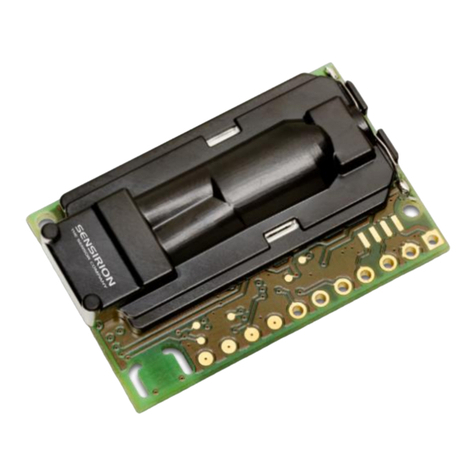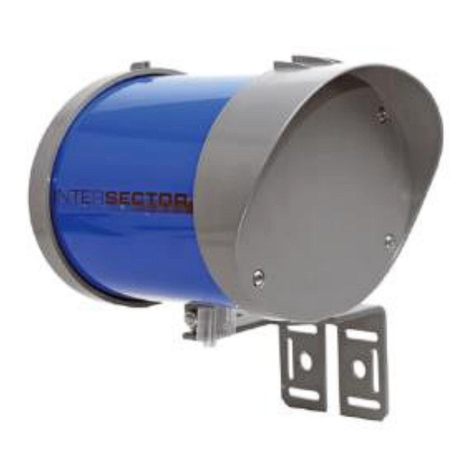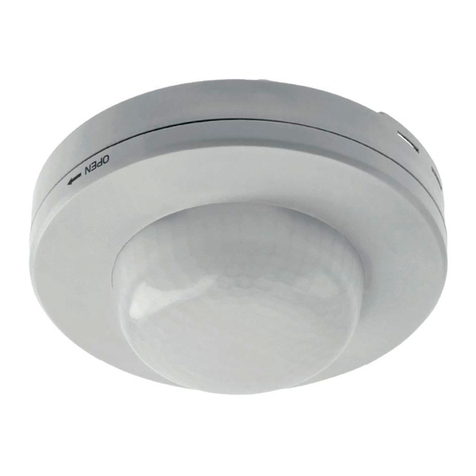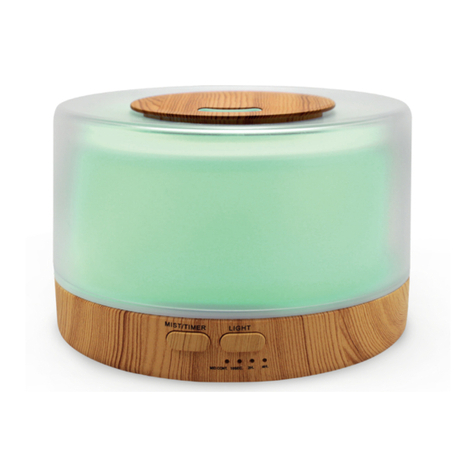GE Lighting CIR-15-360-D-T User manual

General Information
Description
The CIR-15-360-D-T extreme temperature and CIR-2H-360-D-T extreme temperature high bay sen-
sors use passive infrared (PIR) technology with temperature compensating circuitry to control light-
ing in applications where extreme temperatures/humidity must be tolerated. When motion is
detected, the blue wire is electronically connected to the red wire, energizing the relay in the switch-
pack to turn on the load. If vacancy is detected, the blue wire is disconnected from the red, causing
the relay to open, turning off the load. The red lead is +15 VDC supply, the black lead is common, and
the blue is the relay control.
Controls:
Time delay, self-adjust enable/disable, ambient lights setting, HID interface, lighting sweep option,
pull-up option and manual override option are adjusted with the DIP switch. See DIP switch options
under CHECKOUT AND ADJUSTMENT on the reverse.
Installation
NO E: Before you begin, read these instructions completely and carefully.
CIR-15-360-D-T
CIR-2H-360-D-T
Model #
Sensor:
Choose sensor location carefully. The sensor must have a clear view of the area to be con-
trolled. There must be an unobstructed line-of sight from the sensor to any part of the con-
trolled area. For maximum coverage, position the sensor parallel to the longest dimension in
the area.
Switchpack:
The switchpack is generally mounted above the ceiling on
the outside of the junction box that contains a hot line, neu-
tral and the existing switch leg from which the lighting is
controlled. If additional switchpacks are required, they are
mounted on the outside of the boxes containing the appro-
priate switch legs. In installations where there are no exist-
ing switch legs, the switchpack may be mounted on the
outside of any conventional standard junction box, with or
without an extension ring.
Extreme Temperature PIR Ceiling Low Voltage Occupancy Sensor
INSTALLATION INSTRUCTIONS
• Read all instructions on both sides of this
sheet first.
• Plan all component locations carefully.
• For indoor use only.
• Install in accordance with A local codes.
• For use with GE switchpacks and systems
only. For use with other systems contact
technical support.
• Do not run ow Voltage wiring in the same
conduit as power conductors.
echnology: Passive Infrared (PIR)
Electrical Ratings:
Input:
• 10-30VDC from GE Switchpack or GE System.
Maximum current needed is 25mA per sensor.
Output:
• Open collector ouput to switch up to ten GE
Switchpacks.
• Isolated Form C Relay
• Isolated Form C Relay Ratings: 1A
30VDC/VAC
ime Delays: Self-Adjusting up. to 30 min.
Operating Environment:
• Temperature: -40° F – 125° F (-40° C – 52° C)
• Relative Humidity: up to 95% non-condensing
• For indoor use only
Housing:
• Medium impact injection molded housing. ABS
resin complies with U 94V0. Paintable off-white.
Size:
• 3.13”D x 4.5”W x 1.63”H (79.0mm x 114.3mm x
42.4mm)
LED Indicators: Red indicates PIR detection.
Specifications
Model Coverage Field of View
CIR-15-360-D-T Up to 1500 sq. ft. 360°
CIR-2H-360-D-T
When mounted at 25 ft.,
up to 25 ft. in all direc-
tions or 50 linear ft. for
warehouse aisles.
360°
ime Delay:
The sensor has eight (8) discreet time delay settings from 15 seconds to 30 minutes.
Bas Interface:
The sensor has an isolated Form C relay for BAS interface.
Lighting Sweep Option:
If selected, this DIP switch option forces an initial 50-second delay upon “power up” to prevent
false activation in buildings with computer control systems.
Ambient Lights Control Circuit:
Use the Ambient ights controls located on the DIP switch to select the footcandle level at which
ambient light will be sufficient. If ambient light is at the selected level when occupancy is de-
tected, lights will not be activated. The Ambient ights Control Circuit incorporates a deadband
and time delay which ignore brief changes in light levels, such as headlights of a passing car.
High/Low Hid Interface:
Setting the HID control DIP switch to On, allows the lamps to achieve and maintain full brightness
for 20 minutes. The sensor signals the switchpack to keep its relay engaged for the 20 minutes after
initial power up. After the 20-minute warm-up, normal time delay function takes over and bi-level
dimming is enabled. Full auto-off is achieved by installing a timer switch in series to the HID lighting.
Setting the HID control DIP switch to Off allows normal control of fluorescent and incandescent
loads via the switchpack.
Self- Adjusting Feature:
When the delay control is left at 15 seconds (for installer test), the sensor will reset the time delay to 6
minutes automatically after remaining off for one complete hour.
Setting the Self Adjust DIP switch to ON disables the self-adjusting feature.
emperature Compensating Circuitry:
Temperature-compensating circuitry stabilizes sensitivity at temperatures from -40°C (-40°F) to 52°C
(125°F) to avoid false activations. If the temperature is outside of this range, lights will remain on and
the ED will blink three times every five seconds.
Location
These sensors are designed specifically for parking structures, cold storage areas, and other appli-
cations where extreme temperatures exist. Use CIR-15-360-D-T in areas up to a maximum of 1,500
square feet of major motion at a mounting height of 8 feet. Coverage of CIR-2H-360-D-T is twice
the mounting height when mounted up to 25 feet. In a warehouse aisle, a sensor mounted at 25
feet will provide coverage for 25 feet in any direction or 50 lin. ft.
Coverage
CIR-15-360-D- CIR-2H-360-D-
Major Minor
30'
10'
0'
10'
20'
30'
20'
25’
SIDE VIEW
TOP VIEW
0
30’20’
10’
0
10’20’30’
30’ 0’
p
20’ 10’ 10’ 20’ 30’
30'
10'
0'
10'
20'
30'
20'
0'
8'
25' 11' 7' 3' 0' 3' 7' 11' 25'
SIDE VIEW
TOP VIEW
30’20’10’010’20’30’
Sensor:
The sensor mounts to normal ceiling tile through a
single 3/4” hole. The threaded mounting post may be
cut down if it is too long to fit into the junction box.
The sensor may also be surface mounted or mounted
to a standard NEMA 2S or 4S junction box.
CAU ION: Finger-tighten the nut to avoid stripping
the mounting post. Do not apply pressure to Fres-
nel lens.
Backplate:
The sensor can be easily snapped onto or pulled away
from the backplate without disturbing the mounting
hardware. To pull the sensor away from the backplate,
place your fingers on the door on the front of the sen-
sor and slide your fingers up onto the back end of the
sensor, with your fingers resting below the edge of the
backplate. As you press against the sensor, use your
other hand to grip the opposite end of the sensor and pull it away from the
backplate.
To snap the sensor back onto the backplate, place the end of the sensor without a door
against the backplate first, hooking the edge of the sensor on the two small prongs that ex-
tend from the backplate. Press the other end of the sensor against the backplate until it snaps
into place.
Switchpack:
Designed to be mounted externally to any junction box. When mounted, line connections
are inside the box and the Class 2 wiring exits through the rear of the switchpack housing. In
areas where Class 2 wiring is not permitted, the switchpack can be mounted internally to any
standard electrical box.

Chec out and Adjustment
Manufactured for GE Lighting
General Electric Company
Nela Park Cleveland, OH 44112
1-877-584-2685
www.gelightingcontrols.com
© 2011 GE
Limited Warranty
GE warrants that the product will be free from defects in material, workmanship, and title. This warranty applies only to
defects that appear within five (5) years from the date of GE’s invoice (except for defects in title, which shall have no time
limitation). If the product fails to meet the above warranties and if Purchaser notifies GE in writing within thirty (30) days
after discovery of the defect, then GE shall correct such defect by either (at GE’s option) replacing the defective part or
product (f.o.b. GE’s plant or other point of shipment, with freight allowed to destinations within the continental United
States, Alaska and Hawaii) or refunding the price. The foregoing warranties apply only to product purchased directly
from GE, and do not apply to failures caused by acts of God or as a result of any improper installation, maintenance,
storage or service, any accident, abuse, misuse, abnormal use, modification, misapplication, use in violation of any ap-
plicable standard or code, any failure attributable to any associated or complementary products not supplied by GE, or
any failure to comply with any applicable recommendations of GE. GE reserves the right to examine the failed product
to determine the cause of failure. THE FOREGOING WARRANTIES AND REMEDIES ARE EXC USIVE AND SHA CONSTITUTE
THE SO E REMEDY OF PURCHASER AND THE SO E IABI ITY OF GE WITH REGARD TO DEFECTS IN, OR FAI URE OF, THE
PRODUCT WHETHER THE C AIM IS IN CONTRACT, INDEMNITY, WARRANTY, TORT (INC UDING NEG IGENCE), STRICT IA-
BI ITY OR OTHERWISE. GE MAKES NO OTHER WARRANTY, STATUTORY OR OTHERWISE, AND NONE IS TO BE IMP IED. IN
PARTICU AR, WITHOUT IMITING THE FOREGOING, NO WARRANTY OF MERCHANTABI ITY OR FITNESS FOR A PARTICU AR
PURPOSE IS MADE OR IS TO BE IMP IED.
Res. #9590812
Printed in USA
DIP Switch Settings
Wiring Diagram 1: One switchpack, one sensor - occupancy control with manual switch option
Troubleshooting
LED will not turn ON:
• Verify 10-30 VDC across the red and black wires of the sensor.
• Unless connected to a momentary switch for manual control, ensure that DIP switch 1 is in
the default position.
• If there is no power at the sensor, check for 12-18 VDC at the switchpack output and 120 VAC
or 277VAC at the switchpack input. Verify correct primary connections.
• If the voltage is OK at the switchpack, recheck all wiring and connections.
• If the ED still does not operate, please contact technical service.
Lights will not turn ON:
• Confirm that no other switches or equipment are interrupting or bypassing power to the
switchpack or load.
• Unless connected to a momentary switch for manual control, ensure that DIP switch 1 is in
the default position.
• Short the blue and red switchpack control leads together to energize the relay.
• If the lights turn on, contact technical service.
• If the lights do not turn on, check wiring on the switchpack load side and check the switch-
pack contacts for continuity. Replace the switchpack if necessary.
Lights will not turn OFF:
In smaller rooms, the sensor may be activated by people moving in the hallway outside the
room. Adjust the Sensitivity control toward minimum to prevent this or relocate the sensor. If
the lights will not turn OFF after the time period set on the sensor, and the ED has not lit dur-
ing the time period:
• Confirm that no other switches or equipment are interrupting or bypassing power to the
switchpack or load.
• Make sure DIP switch 4 is in the default position, and the bypass switch is in the “Auto” posi-
tion.
Note: If multiple sensors/switchpacks are installed, check one at a time.
Manual-On Override Switch:
The sensor has a built-in override switch on the printed circuit board designed to turn the load
on in the event of sensor failure when the sensor can not be replaced immediately. The switch-
pack must be operative for this switch to work. If the switchpack is defective, it must be re-
placed or bypassed to activate the load. To operate this switch, remove the cover of the sensor
and move the override switch from the “auto” position to the “on” position. All switchpacks
connected to the sensor will now be energized. If multiple sensors control the same switch-
pack(s), activating the override switch on any one sensor will activate all of the switchpacks.
Sensor Cover Removal:
1. To remove the cover from the sensor unit, grasp the corners and pull down gently. Unit will
snap open.
2. ocate the manual-on override switch and move to the “Auto” to “On” position. “Auto” posi-
tion is towards the wire harness. “On” position is away from the wire harness.
3. To replace the cover, position controls to line up with the holes in the center of the cover.
Unit will snap closed.
1. Dip Switch Controls are located under the door on the face of the sensor. Before opening
the door, review factory settings to determine if changes are necessary. The factory setting
on all switches is the OFF position.
If you elect to change some of these settings, open the door using a screwdriver.
2. Verify that DIP switch 10 is in the “Off” position to ensure the sensor is not in override mode.
3. Stand completely still or leave the room. In approximately 15 seconds, the lights will go out.
4. Test the area of coverage by watching the ED on the sensor. The red ED lights when the
sensor is detecting motion.
5. Using the chart at right, set the time delay to the desired time for
the lights to remain on after the occupant leaves the covered
area. Minimum setting is approximately 15 seconds (for installer
testing); maximum is about 30 minutes. The recommended time
delay is usually six to ten minutes. In applications where motion
is minor the sensor may need a longer time delay. If the lights go
out while the room is occupied, increase the time slightly until
optimum time delay is reached.
6. If you choose to disable the Self-Adjust feature, move DIP 4 up-
wards to the “on” position.
7. Using the chart at right, set the ambient light level. Select the foot-
candle level at which ambient light will be sufficient and artificial
lighting will be unnecessary. At this level the sensor will not switch
lights on when motion is detected. If you do not want ambient light
to impact the sensor, select the off setting. If lights go on when
there is adequate ambient light, decrease the footcandle setting.
8. If application involves the use of HID lamps, set the HID Interface Control to ON for proper
HID oad Control. If fluorescent and incandescent lamps are used, set the HID Interface
Control to OFF.
9. To avoid having lights controlled by the sensor swept on by a BAS or EMS, set the ighting
Sweep Control to ON.
10. If connecting directly to a BAS system which does not provide pull-ups, select the Pull-Up
Option by moving DIP 9 to “on.” This will allow the sensor to signal the BAS when there is
occupancy and will avoid the need for additional wiring at the system panel.
143
2
Off
On
1
Time Delay
4
Self Adjust
3
Time Delay
2
Time Delay
5876
5
Light Level
6
Light Level
7
HID Interface
8
Lighting Sweep
9
Pull-Up
1
10
9
132
0.25
6
10
14
18
22
26
30
Switch No.Time Delay
(Minutes)
echnical Service: 1-877-584-2685
Wiring
CAU ION: Before installing or performing any service on a GE system, the power MUS be turned
off at the branch circuit breaker. According to NEC 240-83(d), if the branch circuit breaker is
used as the main switch for a fluorescent lighting circuit, the circuit breaker should be marked
“SWD.” All installations should be in compliance with the National Electric Code and all state
and local codes.
NOTE REGARDING COMPACT F UORESCENT AMPS: The life of some compact fluorescent lamps
(CF s) is shortened by frequent automatic or manual switching. Check with CF and ballast manu-
facturer to determine the effects of cycling.
CAUTION: For use with 10-30 VDC only. For other voltages, refer to GE Tech Sheets. Do not wire to
control receptacle circuits. Confirm supply voltage before wiring the switchpack. Make sure the
switchpack is the correct model for the voltage being used. VERIFY that the connected load does
not exceed the switchpack ratings. Use twist-on wire connectors for all connections. All installations
should be in compliance with the National Electric Code and all state and local codes.
DO NOT control more than ten switchpacks with a single sensor.
GE sensors are provided with Teflon-insulated pigtails. The components are interconnected using
18 AWG Class 2 wiring per NEC 725. Use U -recognized Teflon insulated wire approved for
plenum areas per NEC 725-2(b) where required.
Wire the sensor(s), switchpack(s) and load as shown in the Wiring Diagram.
Controlling Multiple Circuits: CAUTION: In situations where an office is wired for multiple circuits
using separate hot leads, it is very important to connect only one circuit to each switchpack. You
may combine the low voltage wiring from switchpacks connected to different circuits. Consult
with the building manager and occupant to determine which lights should be off when the toggle
switch is open.
56
Off
3
5
Switch No.Light Level
(FC)
10
Measured at 30” off the ground.
This manual suits for next models
1
Table of contents
Other GE Lighting Accessories manuals
